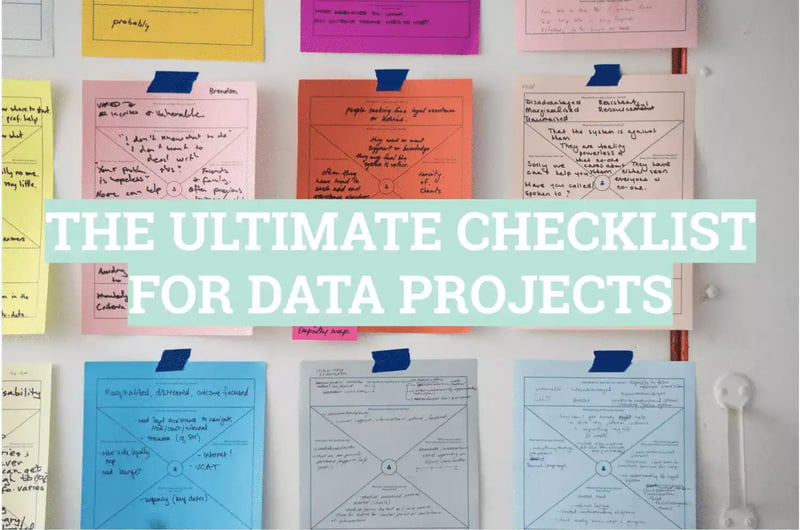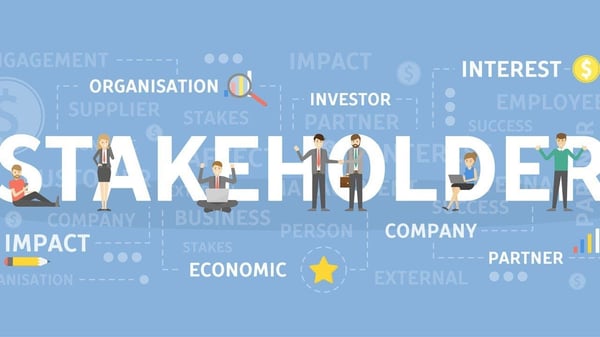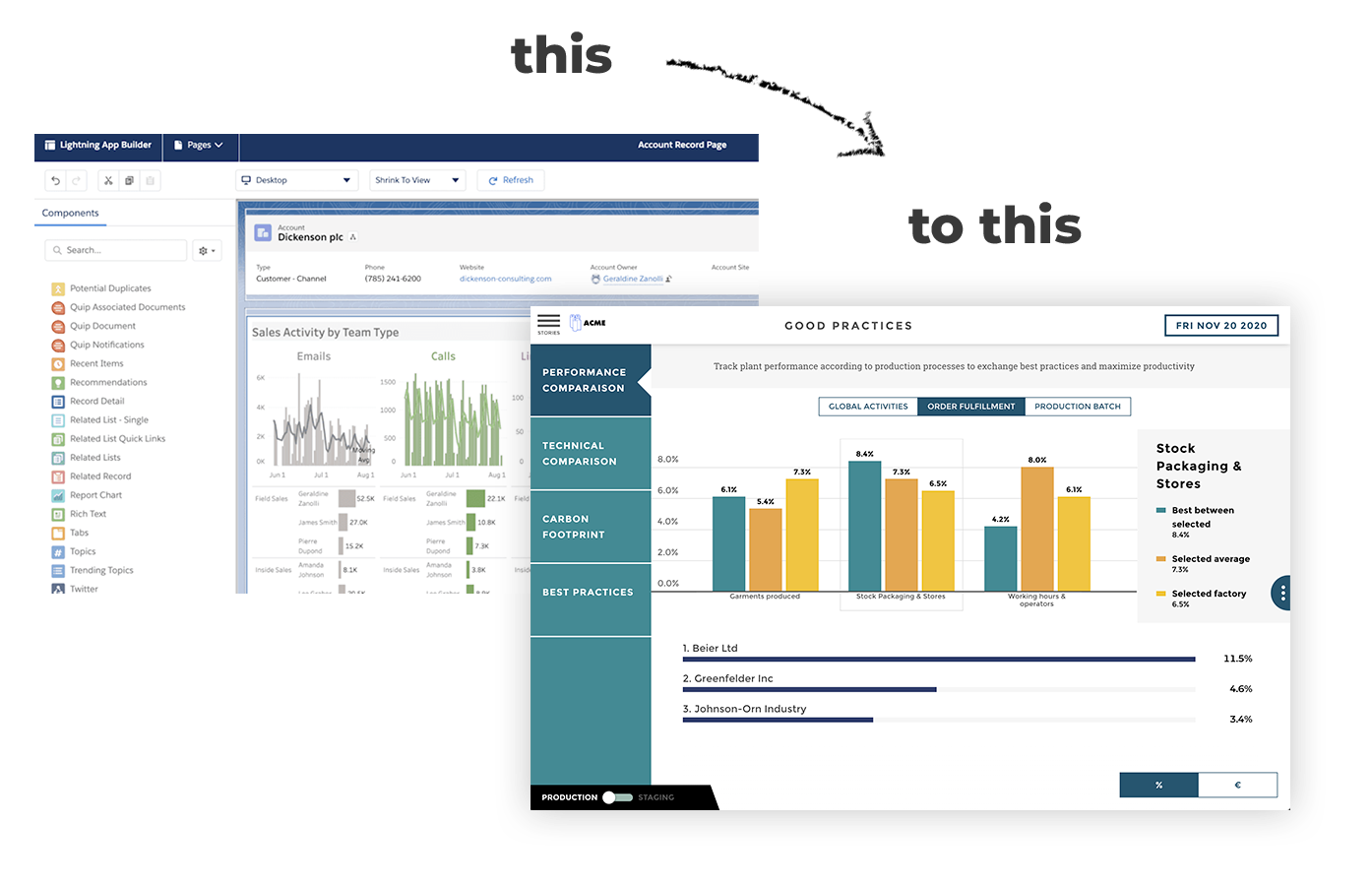
We love data, and we love checklists. So we decided to put one together for other business users in the software industry to share what we've learned.
Here is a little bit of context, so you understand our data project playground.
At Toucan Toco, we want to mae people successful by helping them to make better decisions based on data. Our web app shows data in well-designed and playful data visualizations and storytelling. Access to data is not a privilege for a happy few anymore.
Our clients are all kinds of decision-makers and teams in Fortune 500 companies: CIO, CMO, C-LEVEL, HR departments… you name it. What we call “projects” are the setup and configuration of our software within these companies.
After delivering more than 300 data projects to more than 100 clients in the past five years, we found a golden rule to install pure joy, happiness, and success into data-driven projects. It starts with :
A shared vision, acknowledged and respected by all.
It is like creating your own state with a set of rules that everyone commits to following. How do you enforce these rules? On what pillars do they stand?
We created the ultimate checklist of the alignment levers to guarantee successful data projects and are happy to share this with clients/buyers, as well as project managers. Read on to learn more about what it encompasses!

1. Our recipe is simple
- 1 Delicious Pain, so you complete a data project that makes sense.
- 4 Committed Stakeholders, who can arbitrate between options during the project.
- Clear Key Success Factors, so you know what needs to be checked to consider that the project is a success.
- A Slice of Data, because there isn’t such a thing as qualitative data and the available one.
- Excellent Communication, so everyone is always on the same page
- 1 Methodology, so everyone acts consistently.
Mix it with good energy, a good mood, one a beautiful smile, and voila: success!
Data projects are about getting your delivery team working together, following a set of rules that will lead the project to success.
Now, let’s deep dive, and explore the magic of successful project management.
#2 Building the dream team for each data project
The People you need around the table:
- Sponsors
- Business Owners
- Data Owner
- Project Manager
Each of these is responsible for a specific workstream of the project. So, having these four stakeholders committed to the project is critical for the success of the project. If one of these people is not defined, ax your project: it won't generate the results you expect.
Here is a breakdown of each key contributor's role in a data project:
- The sponsor that the project will be pushed forward before, during, and after the project delivery. You need people who actively believe in the project to motivate the troops and promote the work efficiently within the company. We call these people champions.
- Business owners know the reason why we need to do something. Set the goal of the project by sharing their pains, frustrations, or needs, providing food for thought, validate the implementations made during each step of the project.
- The data owner (DO) feeds the project with realistic materials. “DO” knows where the information is, how to extract it, or how to manipulate it to produce valuable insights. He is responsible for on-time data delivery, is the guardian of a pragmatic approach, the key to ensuring successful project delivery.
- The project manager (PM) is the orchestra conductor. He is responsible for the global monitoring of the project, its rhythm, timing, and closure, establishes efficient communication between the other stakeholders, prevents the project from deriving from its original scope.
#3 Golden rules to make a data project successful [step by step]

-
Step 1: Know your end-users
The dream team must identify the persona of the project. You must know the answer to the question: Who are the end-users?
As, you want their lives to be easier at work, help them make better decisions by developing this project. Now, let’s make sure that we know who these end users are, their pains, and how the answers we find may change their lives.
You should identify the persona of your end-users, so the project meets their expectations and answers their needs.
-
Step 2: There is no long-term success without pain
A successful data project is a useful project, a project with a purpose, and a project that provides a return on investment.
You want the answer to this pain or business need. The project output is that answer to the pain or business need. It is a frame you can refer to when you need to make decisions on the project.
-
Step 3: Define Key Success Factors
All stakeholders must communicate key success factors (KSFs). [Disclaimer: Please engrave your KSFs in marble.]
Depending on the stakeholder, the success factors can be different. Writing them down makes a real difference. For some, there might be a deadline, for others a specific functionality.
For instance, for a sales dashboard, device responsivity can be a KSF if the sales team needs access to their performance figures from different devices (smartphones, computers, etc.). Or perhaps they need data available in two languages.
You can figure out that having all the stakeholders agree on the KSF gives a frame to the project. It also commits everybody to the same goal, so make sure you refer to it when you need to make a decision.
-
Step 4: Available Data
Duh! A pain or defined business need is essential, but you also need data to bring value to the project. Data must be available, clean, and properly formatted to be used efficiently in a project.
The data owner handles the data complexity. The data owner is necessary to create value from the data and to deliver it to the end-users.
-
Step 5: Recurring communication
You want open communication. Clear, honest, scheduled, and recurring communication. Also, this works better with a dedicated tool.
At Toucan Toco, we chose Trello to manage our projects and to host all our interactions with the project stakeholders.
We open a new Trello board to all the stakeholders at the beginning of each project. We gather every vital piece of information (contacts, meetings minutes, Key Success Factors, actions, and more) in one place. Also, there are no emails. Everybody has access to the same level of information and can interact with each other.
Everything is out in the open, nothing is hidden, and everybody assumes responsibility for their dedicated tasks.
-
Step 6: A Methodology to rule them all
Your project methodology must be acknowledged and respected by all. Everybody needs to believe in this methodology and be ready to commit to following it for the sake of the project. Your methodology allows you to timebox the project and make sure that it doesn’t drift over time.
At Toucan Toco, we created our project methodology inspired by agile principles. We believe that to deliver our projects quickly and efficiently, regularly getting feedback is necessary.
We decided to slice the projects into sprints/iterations, where the stakeholders can express their feelings and thoughts about our developments.
From Day 1, we work on the final material, and we improve it together with the stakeholders over time and iterations. It is all about getting and prioritizing their feedback.
All our projects follow the same methodology and project journey.

Here we are: a robust project methodology that gives us precisely more confidence in data project management. It enables us to deliver our projects efficiently. And, as a consequence, it boosts client satisfaction.
But precisely how do we manage to take decisions to make these customers happy, or to perform better? You might say, “well, the figures speak for themselves!” They do, but without any context, it’s not so simple.
Read about the impact of data storytelling on customer satisfaction!





